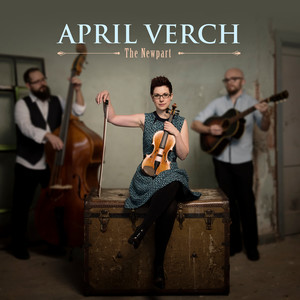
- 歌曲
- 时长
简介
Fiddler, singer, and stepdancer April Verch knows how relevant an old tune can be. She grew up surrounded by living, breathing roots music—her father’s country band rehearsing in the “Newpart,” the beloved Verch family room; the lively music at church and at community dances; the tunes she rocked out to win fiddle competitions—and decided early she wanted to be a professional musician. She took that leap, and has been quietly leaping into new, nuanced places for more than two decades. Moving from exuberant stepdancer to fiddle wunderkind and silver-voiced singer, Verch may still spend many a fond hour rehearsing in the Newpart, when at home and not on tour, but like tradition itself, she has never been content to stand still. “When you really know and love this music,” Verch reflects, “you want to go deeper, to bring out new dimensions, without straying too much into novelty.” Now on her milestone 10th album The Newpart (release: April 7, 2015), with producer Casey Driessen, Verch digs deep into songs and tunes from the era before the often-mined mid-century heyday of bluegrass and folk. Harkening back to vaudeville and beyond, Verch and her fellow trio members pare down their arrangements, highlighting the simple pleasures of upright bass, guitar, clawhammer banjo, mandolin, voices, fiddle, and stepping in intimate conversation. At the heart lie Verch’s delicate voice, energetic footwork, and stunning playing, a trifecta of talents she brings together simultaneously for the first time on stage and on The Newpart. It all works to insist that, “these songs don’t need to be revived,” Verch exclaims. “They are timeless. They are still very much alive and relevant.” The album’s title pays tribute to a special space in the Verch family home, where old meets new. The house, a one-room schoolhouse her parents attended, received a new addition the same year Verch was born. It was dubbed “The Newpart." With the exception of the large collection of trophies April and her sister won for their music and dancing, it hasn’t changed much over the years, right down to the 70's shag carpet. To Verch, it’s the perfect symbol of family, tradition, and music, the things she values most: “It’s the place we gather to jam, to practice songs for family baptisms, funerals, and weddings. It’s where I practiced countless hours and wrote many tunes, including the songs on this album. It’s where we take family pictures, visit and entertain our guests. It’s the most special place in the house, the scene of my most cherished memories.” Many years ago, Verch was up on stage at the county fiddlers’ monthly dance event in her native Ottawa Valley. She was a darling among the fiddlers there, a cute kid who could play beautifully, and the more seasoned players encouraged her. But April noticed something: “When I played a waltz, even though I had decent tone and technique, the floor didn’t fill up. At the urging of my Dad, I began to listen to the way elder fiddlers played, and watched how, even if they were a little scratchy, they got people dancing.” Verch marked that lesson well, even as she plays with the tradition she inherited. She keeps the community-fired celebratory side of her music at the forefront, honing a keen awareness of how to engage contemporary listeners. With ten albums and years of touring under her belt, Verch has moved from upstart prodigy to mature and reflective songwriter, interpreter, and storyteller. Verch’s inspiration often comes from unexpected quarters: the mix made by a dedicated fan or regional music aficionado (how Verch discovered many of great Old-Time American tunes in her repertoire), a field recording played in the tour van that left Verch and her two trio-mates (guitarist Hayes Griffin and banjo/bassist Cody Walters) dumbstruck. The rough blues gems, the ballads with roosters crowing and dinner cooking in the background: Old recordings often touch Verch, Griffin, and Walters profoundly. Yet Verch never forgets the roots of her music, that connection to the people out there in the audience, on the dance floor, to the community sparked by a good song. It’s about doing less to engage more. “I’ve lived with these songs and tunes, and my job is to get out of the way and let them hit the listener. To let them shine on their own and to leave space for interpretation,” Verch muses. “It’s all about touching people, about bringing them together in a community to celebrate music. I’ve understood that better and better as time has passed: how to take this music that is at the center of my life, and make it live and breathe for other people.”







